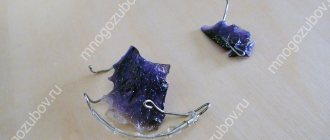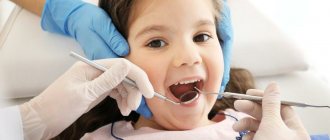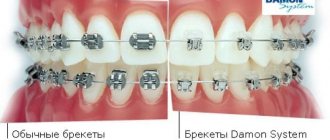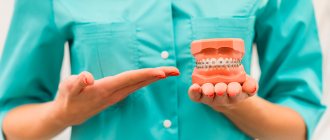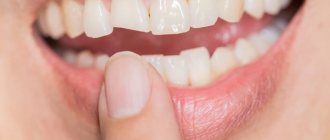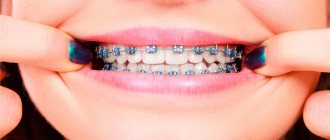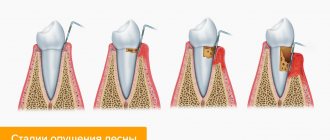Why do they put braces on teeth?
Installation of braces is a common method of orthodontic treatment. These structures help correct malocclusion, straighten teeth and help make your smile beautiful.
In this article
- Why do they put braces on teeth?
- How is a braces system installed?
- The bracket came off: what is the reason?
- What to do if the bracket comes off?
- The bracket has come off - what to do? Option 1
- Option 2
- Is it possible to reinstall a loose bracket?
- How does gluing happen?
- How long can you walk without braces?
- What to do if the last bracket comes off?
- Prevention of braces coming off
- Conclusion
Braces are small plates attached directly to the surface of the tooth, which are combined into a common system with a metal arch with shape memory. The orthodontist first calculates where the bracket should be placed on the tooth so that the displacement occurs in the right direction. And when the arch tries to return to its original shape, it puts pressure on the braces, and they, in turn, affect the teeth.
What do you wear after braces are removed?
Without the pressure of the orthodontic system, the teeth will try to return to their original position if not prevented. To prevent the teeth from becoming crooked after the braces are removed, the patient is fitted with a special retainer that fixes the dental units in the desired position to secure the result. Such structures are divided into removable and non-removable.
- Fixed retainer.
A thin wire is glued to the inside of the teeth using a filling material. The arch is absolutely invisible when worn, does not affect diction and does not cause discomfort. - Removable retainer.
We are talking about a silicone mouthguard, which is made according to individual impressions of the patient’s jaws, or retention plates after removing braces, intended for use while sleeping.
The retention period exceeds the duration of treatment by at least 2 times. Some patients wear a retainer throughout their life.
How is a braces system installed?
First, based on X-rays and digital photographs, the orthodontist makes the necessary calculations and draws up a personal orthodontic treatment plan. Then, together with the patient, he selects a suitable brace system (metal, sapphire or plastic, external or internal). The next stage is preparation for the installation of braces, in particular the sanitation of the oral cavity. At this stage, it is necessary to cure caries and other diseases, replace old fillings with new ones, and, if necessary, separate or remove teeth that may interfere with the correct displacement of other units in the dentition. After sanitation, you can proceed directly to fixation. How is the bracket attached? There are two main installation methods - direct and indirect fixation. In the first case, plaque is removed from the enamel surface, etched, an adhesive base is prepared, the bracket is fixed using a composite material, and polymerization is carried out with light. With indirect fixation, braces are installed from a mouthguard previously made using photographs of the patient’s jaw. After preparing the enamel, the aligner with braces is fixed to the teeth and polymerized with light. The indirect fixation method is considered more accurate and takes half as much time as direct installation on each tooth separately.
After gluing the braces to the surface of each tooth, they are connected to each other using a metal arch. Attaching the arch to the braces can be done using the ligature method - using clasps and elastic bands. Or without ligation, when the arch is fixed with special clips.
What do you do after removing braces?
The treatment process does not end with getting rid of the orthodontic structure. The doctor will perform several procedures to restore your teeth to their natural color and attractive appearance.
With the help of professional hygienic cleaning after removing braces, the remaining glue, plaque and tartar that have accumulated under the clasps while wearing the device are removed from the tooth surface. Remineralizing therapy and fluoridation saturate the enamel weakened by constant stress with the necessary substances.
After removing braces, teeth whitening is recommended no earlier than a month later, when the condition of the dental tissues improves. Premature lightening threatens increased sensitivity and prolonged pain.
The bracket came off: what is the reason?
Sometimes a patient who wears an orthodontic device encounters such a problem that the bracket falls off. Let's look at the main reasons that can lead to such a situation.
- Inaccurate brushing of teeth.
The presence of braces in the mouth greatly complicates the process of oral hygiene. For careful and thorough dental care, a regular brush is not suitable, but several devices are needed at once - a brush with V-shaped bristles, a brush for cleaning teeth under the arch and an irrigator. If you use these devices carelessly or try to clean the braces with a regular brush, pressing hard on it, the plates may fall off.
- Poor hygiene.
The brace can come off not only due to too much activity, but also due to poor oral hygiene. In this case, cariogenic bacteria accumulate around the plate, plaque forms, which leads to the destruction of the enamel and the bracket coming off.
- Eating solid foods.
After installing the braces system, the dentist must provide nutritional recommendations. In particular, in order not to damage the orthodontic structure, it is recommended to exclude nuts, crackers and other hard foods from the diet. Dentists also do not recommend overusing toffees and other products that stick to teeth. If the patient neglects these recommendations, the situation when another brace falls off will be repeated regularly.
- Features of fixation.
Braces are attached to the surface of the tooth with a special glue. It has such a composition that after the end of orthodontic treatment the structure can be removed without damaging the tooth enamel. Thus, this adhesive composition, although quite durable, is not able to withstand every load. As part of the design, each bracket is pressed to one degree or another by a power arc, which thus “pulls” the teeth along with it. If a person has crowded teeth or a severe malocclusion, the pressure on different braces will be uneven. Due to this load distribution, some plates may come off. Most often this happens in the first days and weeks after installing the braces system.
- Unprofessional approach.
Some dentists use filling material instead of a special adhesive to glue braces. This method of attachment is less reliable, and braces fall off more often. There are also doctors who, when attaching plates, do not take into account the individual anatomical features of the patient, and the bracket can come off simply when the teeth are closed.
Thus, the reasons for the unsticking of the braces can be the actions of both the patient himself and the orthodontist. In both cases, the main question is what to do if the bracket falls off?
Procedure
What to do if a brace falls off? If the bracket has come off the surface of the tooth, then this situation is certainly unpleasant, but not catastrophic. The most important thing is to follow a certain algorithm of actions in order to avoid serious consequences.
If a problem occurs during the day, you should immediately contact the treating orthodontist who installed the structure. In such situations, the doctor should schedule an appointment on the same day.
The specialist must not only eliminate the design defect, but also once again remind the patient about the rules for using the product.
Note: If the breakdown occurred at night or on the orthodontist’s non-working days, you must make an independent decision. The main task is to remove the arc from the structure. Removal of the ligature is done very carefully using small tweezers. In this case, you need to carefully pry it off by the edge; you can use a regular toothpick.
These actions are carried out with one purpose - to avoid uneven distribution of pressure on the dentition. If there is no arch in the bracket, then it is necessary to remove the fastening element of the fixing lock. You cannot throw away the lock from the structure. The doctor should carefully examine the fallen part and decide whether it is worth re-installing the lock or whether it is better to use a new element. In orthodontics, as a rule, clasps are very rarely reused, since when peeled off they lose their fastening properties. Re-installation of fasteners can be done for only one purpose - saving money, since a new product requires certain material investments.
What to do if the bracket comes off?
The most correct thing to do in such a situation is to immediately call the orthodontist and make an appointment, and not try to glue the braces into their original place yourself. When the plate is not attached to the tooth, it does not perform its main function - correcting the bite. But the worst thing is that the overall effectiveness of orthodontic treatment is impaired. As other teeth gradually shift, one remains in place. This violates the treatment plan precisely calculated by the dentist and can ruin the entire process of bite correction or increase the period of wearing the braces.
Unfortunately, it is not always possible to quickly see a doctor: sometimes a specialist has an appointment several days in advance or you are in another city. Is it worth removing braces at home or what is the right thing to do in this case? Your actions will depend on whether the bracket is held in the arch or not.
How are braces removed from teeth?
Most patients know virtually nothing about how braces are removed. The procedure is simple and involves several manipulations. Before the doctor begins work, you can ask him how long it takes to remove braces. As a rule, regular clasps are removed in about twenty minutes, and a lingual system in just under an hour. Any orthodontist can remove braces, regardless of whether the person is his patient or not.
The process of removing braces involves several stages.
- Preparation.
A retractor is installed for the patient to protect the oral mucosa from damage. - Removal of the structure.
The ligatures and arches are removed first, then the braces themselves. - Grinding.
Remains of glue are removed from the teeth by polishing, and the enamel is coated with a remineralizing composition.
Does it hurt to remove braces? Definitely not. Dental procedures cause some discomfort, but the discomfort is quite minor and mainly depends on the individual pain threshold.
The bracket has come off - what to do? Option 1
If it comes off, but is held in a metal arc, proceed as follows. Pull the bracket out of the archwire. To do this, on non-ligature models it is enough to unfasten the clasp; on ligature models, you need to remove the elastic bands (these are ligatures). This can be done using tweezers, a toothpick or nail scissors. The goal is for the rubber band to come off the bracket. If you can’t remove it carefully, you can cut it, and the orthodontist will then easily replace the damaged ligature with a new one. Be sure to keep the braces and give them to the doctor when you see him.
The archwire flew out of the bracket, what should I do?
- Most often, thin wires used at the beginning of treatment fly out of the last braces. Experienced orthodontists know how to minimize such phenomena. In particular, the arch can be bent behind the last bracket; in addition, thin arches are often placed only up to the sixth teeth, since they often fly out of the tubes on the seventh teeth. If this trouble nevertheless happens to you, try in front of a mirror using tweezers or nail clippers (just don’t bite off the arch!) to tuck the arch into the tube on the last tooth: this manipulation is akin to threading a thread through the eye of a needle. If you can’t do it or you don’t want to acquire new skills, then contact your orthodontist, he will quickly fix the problem.
- The arch can also shift due to low friction in the system (primarily applies to self-ligating braces). In this case, the archwire protrudes from one side and slides out of the last bracket on the other side. This happens because the orthodontist either forgot to fix the stoppers on the arch, or they turned out to be ineffective for one reason or another. The problem is resolved in the same way as the first point.
- When closing gaps or correcting crowding of teeth, the length of the dentition decreases, but the length of the arch remains the same, respectively, an excess of the arch appears behind the last braces. If the tip of the arch is large enough and pricks your cheek, then visit your orthodontist (by prior arrangement, of course), he will remove the excess arch in a couple of minutes. If the tips of the arch are visible, but do not seriously bother you, then do not worry and come to the next scheduled appointment, because this is a sign of progress in correcting the bite.
Option 2
Do not try to remove a loose bracket if it is tightly held in a metal arch. In this case, the best option is to do nothing until you see a doctor. If you are afraid of losing the plate while eating or brushing your teeth, you can temporarily secure it with special orthodontic wax. It’s definitely not worth trying to forcibly tear the bracket away from the structure, because you can damage the entire device. In this case, it will need to be completely replaced, which will cost a lot of money and time.
If you can't remove it?
If for some reason you were unable to remove the loose bracket, you need to put aside independent attempts to correct the situation and wait to see a specialist.
It's no secret that a dangling element will cause you a lot of inconvenience while sleeping or eating. However, this problem can be solved.
How and why to fix it?
You can temporarily fix a particle of the device on the enamel using orthodontic wax. This remedy is capable, although not of correcting the entire current situation, but of eliminating the feeling of discomfort.
Note! Under no circumstances should such repairs be used to fix the staple element for the duration of the entire treatment.
Only a qualified specialist has the right to install a detached element or replace it.
Improper fixation of the bracket can lead to disruption of the system’s effect on the dentition. As a result, the correction will not lead to the expected result.
Design differences of Pilot braces, indications for use and terms of wearing.
Let's look at the device of Win lingual braces here.
At this address https://orto-info.ru/sistemyi-vyiravnivaniya-zubov/breketyi/po-tipu-materiala/keramicheskie/clarity.html see photos of Clarity Advanced braces.
Is it possible to reinstall a loose bracket?
Braces are not cheap. Therefore, when they come off, patients often ask doctors not to install a new plate, but to fix the one that has fallen off. The dentist can accommodate you if the braces are not damaged. But according to the standards of orthodontic treatment, this is not recommended. In particular, because such braces have already damaged the adhesive coating, which enhances adhesion to the glue, and they can fall off again.
What can and cannot be eaten with braces?
This question worries every person undergoing or planning orthodontic treatment. In fact, only a small list of products are completely banned:
- Viscous and hard candies : toffees, nougat and so on. They can easily cause the braces to come off; in addition, the pieces get stuck in the equipment and are extremely difficult to remove.
- All types of nuts : there is a high probability of braces coming off with any careless movement.
- Chewing gum : gets stuck under the archwire and around the braces. Often the cause of peeling off.
- Rusks, dryers, hard cookies and gingerbreads, biscuits and other hard types of flour products
- Popcorn
- Bones (unexpected, isn't it?)
In addition, you should be very careful with the following products (it is very difficult to clean residues from the braces system):
- Processed cheese
- Corn on the cob
- Bread and other soft flour products
- Chips
- Dried fruits
- Jerky
The following products can and should be eaten. But cut into small pieces (about 1 cm in diameter), since when biting off solid food there is an extremely high risk of braces coming off!
- Grilled meat
- Raw vegetables (carrots, cucumbers and others)
- Hard fruits (apples, pears, etc.)
- Sandwiches and burgers
- Pizza
- Hard breads
How does gluing happen?
As soon as possible, you should go to the dentist to install a new brace. Usually, this requires disassembling the structure, removing arches and ligatures, cleaning, drying the tooth, and repeating the fixation procedures from the very beginning. If only one bracket has fallen off, then re-gluing it will take about 10 minutes. Some dental clinics offer patients 3-4 discounted procedures per year. If braces come off more often, in most cases this is due to non-compliance with the doctor’s recommendations, and you will have to pay for more frequent re-adhesions.
Some patients, in order to save money, try to glue the plate themselves. This cannot be done for two reasons.
- You do not have a special adhesive composition that is suitable for braces and is safe for teeth.
- It is necessary to glue the bracket in the correct position; this is the only way the bite will be corrected. Only an orthodontist can cope with such a task.
Teeth hurt after installing braces: what to do?
- Teeth may hurt for 3-6 days after installing braces and after switching to rigid rectangular arches (usually several days). The intensity of pain varies from person to person, so it’s up to you to take painkillers or not. If the pain is difficult to bear, then take painkillers that help you with headaches. To begin with, you can try: aspirin, citramon-p, nurofen, pentalgin, askafen and analogues. If their effect is not enough, then take more serious non-steroidal anti-inflammatory drugs: nimesil or nise. Do not forget that these drugs reduce the intensity of inflammatory processes, which means they stop the movement of teeth.
- Avoid using ketorol and ketanov as they are very toxic and their prolonged use is a serious risk.
Diagram of tooth movement in bone.
- Use a local anesthetic. There are a number of over-the-counter medications that can help relieve toothache while wearing braces. They have anesthetic properties (they dull the pain for several hours). Available in the form of mouthwashes and gels. For example, "Orajel" or "Colgate Orabase". Sometimes it is possible to be allergic to such drugs, so before use, always review the instructions for the drug; they also indicate the correct method of application.
- Be careful when brushing your teeth! If you are used to pressing hard on your toothbrush when brushing your teeth, you may experience pain. Try to brush your teeth with light and slow circular movements, take your time and open your mouth a little wider than usual. Only use brushes with soft or medium-hard bristles.
- Eat cold food, drink cold water, keep ice cubes in your mouth. Cold reduces the sensitivity of pain receptors. In addition, many of the modern orthodontic wires used at the beginning of treatment are thermoactive. This means that the lower the temperature in the oral cavity, the less force the arc develops (the changes are completely reversible), which means the teeth hurt less. But, you should not abuse this trick: when the arch is weakened, progress in correcting the bite will slow down proportionally.
- If you experience severe pain immediately after wire placement or replacement, tell your orthodontist! When replacing the arch and other manipulations, light to medium pressure is considered the norm; it also ensures maximum speed of tooth movement. Contrary to popular belief, very strong pressure on the teeth does not speed up, but slows down the treatment process and, in addition, causes serious discomfort to the patient.
What to do if the last bracket comes off?
Any brace can come off, but most often patients complain that the bracket on the last tooth has come off. What is the reason? The distant teeth are chewing teeth, which is why they experience increased stress when eating. Therefore, it is easiest to rip off a bracket from a posterior chewing tooth. The procedure for gluing brackets on the outer teeth is no different from that described above. The only difference is that it is easier for the latter to jump off the arch, so it is advisable to immediately remove them and save them until a visit to the dentist.
Let's sum it up
During orthodontic treatment, braces often come off. As a rule, the patients themselves are to blame for this because they do not follow the doctor’s recommendations. First of all, it is necessary to exclude hard foods and sticky foods from the diet. Follow all orthodontist recommendations for caring for the product. In some cases, structural damage is caused by unprofessional actions of a doctor.
If a “breakdown” occurs, the problem must be resolved immediately.
One of the most common problems is a bracket or wire sticking out in the mouth. If this situation occurs in the first 24-48 hours after wearing braces, then this is likely due to a problem with the connection between the bracket and the tooth, or there may be a situation in which a tooth located in one arch falls into a bracket in another arch. In any case, you should call your orthodontist and have your braces properly installed within a day or two of the breakage. Protruding wire can damage the oral mucosa.
If you've had braces long enough and the bracket has become loose, then you probably ate something hard or sticky, despite your doctor's advice, that caused the problem. You should check your braces every night before bed after you brush your teeth to make sure they are in good condition.
If the brace on the last tooth falls off while the orthodontist is not working, then you need to take some measures yourself. Strictly follow the recommendations given in this article and the system will serve you for a long time and will not require additional financial expenses.
Prevention of braces coming off
In most cases, it is possible to prevent braces from coming off if you follow preventive measures, which include strictly following the doctor’s recommendations.
- Dieting.
In the first days after the installation of an orthodontic structure, it is advisable to eat only soft and liquid foods - cereals, smoothies, yoghurts, cottage cheese. It is at this time that the risk of peeling is highest, and following a diet will help prevent it. In the future, you can eat different foods, with the exception of hard, sticky, too small (they will get stuck in braces) and coloring.
- Control of bad habits.
The habit of chewing the tip of a pencil or biting your nails not only leads to chipped teeth, but can also lead to peeling.
- Take good care of your braces.
When cleaning, all movements with a brush or brush should be smooth and careful so as not to damage structural elements. If you use an irrigator, be sure to choose a model with an orthodontic attachment - it is specially designed for gentle cleaning of brace systems.
- Maintain good oral hygiene.
If you don't brush your teeth thoroughly enough near the braces, a carious process can begin, which not only leads to the plate coming off, but also requires mandatory treatment. If the doctor diagnoses caries, the system will have to be completely removed, the teeth treated, and then reinstalled. This can be avoided by regularly cleaning your teeth and mouth, following the hygiene recommendations given by your dentist.
Causes
Braces are a fairly fragile structure, so a patient at an orthodontic clinic is required to follow a number of specific operating rules to maintain the integrity of all elements of the system.
Dental glue has fairly high strength levels, however, there are still some factors that contribute to the destruction of its structure.
Experts include the following reasons for the violation of fixation of orthodontic elements:
- Pathological arrangement of teeth - due to the acute lack of space required for installation of the structure, significant pressure is created on the teeth, which occurs at the initial stage of bite correction.
As a rule, the bracket comes off due to crowding of the bone organs. As a result, even the most minimal arc parameters can create conditions for element rejection. - Abrupt actions by the owner of the structure during hygienic procedures - removing food debris from the area of enamel located under the bracket can, unwittingly, disrupt the fixation of the fastening elements of the brackets.
Inaccurate movements with various types of devices, often with a brush, lead to the braces coming off. - Failure to comply with the operating rules of the structure regarding the consumption of acceptable foods while wearing the system - after installing the systems, experts recommend excluding hard foods from the diet.
Eating hard vegetables and fruits, nuts, seeds, and crackers harms the attachment of braces to tooth enamel by exerting excessive pressure. Failure to follow the specialist’s recommendations will result in the brackets constantly coming off.
Considering the significant cost of orthodontic treatment, you should be more responsible in following the recommendations of a specialist.
The service life of the structures and the result of the correction as a whole depend on your attitude to the process of correcting your bite.
Broken bracket or archwire
If the integrity of the elements of the braces system is damaged, you should immediately go to the doctor.
Arc failure is a rare occurrence. As a rule, the reason is due to certain manipulations of the orthodontist. In any case, it must be replaced with a new one.
If a brace breaks, most often it also needs to be replaced. It should be noted that metal products rarely break. They are characterized by increased strength and last the entire period of correction. Plastic and ceramic systems are more susceptible to breakdowns.

